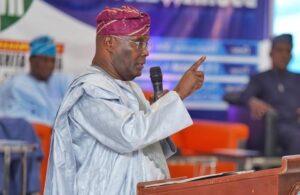By Christopher Okpoko
The World Economic Situation and Prospects (WESP) and the United Nations classifies all countries of the world into one of three broad categories: developed economies, economies in transition and developing economies. But the key difference between the developed world and the developing world is the level of industrialization. Hence, a developed country is a country that has a high level of industrialization and per capita income, while a developing country is a country that is still in the early stages of industrial development and has a low per capita income. Thus, industrialization is generally believed to be a catalyst for rapid growth and development of any economy. As a process, it also presupposes the provision of appropriate institutions by the state.
According to African Development Bank (ADB) industry has always played a vital role in
development. It boosts economic activity along value chains, from raw materials to finished products. It lifts productivity by introducing new equipment and new techniques, increases the capabilities of the workforce, and diffuses these improvements into the wider economy.
Industry also tends to generate formal employment, which in turn creates social stability. It improves the balance of trade by creating goods for export and replacing imports. Industrialization, including the encouragement of manufacturing and processing capability, makes for strong and sustainable economic development, creating wealth in the economy. It is a prerequisite to a country’s sustainable and inclusive growth, achievable through adding value by processing, packaging and marketing its raw materials.
Consequently, since Nigeria’s independence in 1960, a major aspiration of all previous administrations has been to shift from mainly primary based economy reliant on farming and extractive industries such as oil and gas, to one which can make more money or GDP from manufacturing or secondary industries and more services in the tertiary sector. In this regard, several industrial policies over the years have been initiated with laudable objectives that were not achieved, as captured in the review below: (UK Essays: Nov.2018 Review of Industrial Policies in Nigeria)
1. Import Substitution Industrialization (ISI)
ISI was pursued in the 1960s and 1970s with the aim of increasing local production of manufactured goods, generation of employment, preservation of the country’s foreign exchange and expansion of the country’s domestic market for goods locally manufactured. One thing is, however, obvious. Industrial production experienced a tremendous boost as the index of industrial production rose from 41.3 in 1970 to 120.3 in 1979 (CBN, 2005). In real terms, percentage of manufactured in GDP increased from 4.8 percent in 1960 to 8.6 percent in 1979. Compound growth rate of industrial production rose to 9.7 percent between 1970 and 1975 before declining to 6.8 percent in 1976-1980 (Ndebbio, 1991)
.
2. The Nigerian Indigenization Policy (1972-1977).
The Nigerian Enterprises Promotion decree (NEPD), 1972 or Nigerian Indigenization Policy (1972) often regarded as a bench-mark industrial policy came in the wake of the desire to make Nigerians own and control the industrial enterprises in the country. As noted by Ndebbio et al (1991), the indigenization Decree was to give Nigerians the opportunity to demonstrate the ability to assume ownership, control and management of a greater part of the nation’s economy.
Its main objectives were to transfer of ownership and control to Nigerians in respect of those enterprises formally wholly or mainly owned and controlled by foreigners.; create opportunities for the Nigerian indigenous businessmen; maximize local retention of profits; increase the level of intermediate and capital goods production; ensure increased participation of Nigerians in the wealth of their nation; and create employment opportunities for Nigerians to ensure increased level of self-reliance in the supply of industrial output.
This policy, however, suffered setbacks owing largely to insufficient capital, lack of skill manpower and activities of unscrupulous Nigerians who connived with foreign investors to undermine the policy. Consequently, there was distortion in the industrial sector and production index indicated a downward trend. Compound growth rate of industrial production between 1981 and 1986, when the effects of this policy actually manifested, was in the negative, -1.8 percent. It should also be recalled that the huge oil windfall recorded in the mid-1970s actually ceased to flow during this period. The foreign reserve of the country was severely depleted and many industries that relied on imported inputs had to either shut down or operated below full capacity.
3. Structural Adjustment Programme (SAP, 1986)
The IMF engineered Structural Adjustment Policy (SAP) was quick at addressing the issues with the promulgation of the New Industrial policy 1989. This policy tended to reverse some of the provisions of the Nigerian Indigenization Policy and opened up the economy for foreign investors. The policy also provided for empowerment of domestic businesses through the National Economic Reconstruction Fund (NERFUND). The introduction of SAP resulted in very negligible and mild recovery, with mining recording the highest compound growth rate of 0.30 percent. Whatever was gained during the SAP era was destroyed during the Abacha regime. The destruction was so deep that many years of economic reforms and democracy have not yet been able to fully repair the damage.
This policy came to being in order to right -wrong the weaknesses and ineffectiveness of earlier industrial policies. Its aims and objectives included to; promote investment; stimulate non-oil exports and providing a base for private sector led development; promote efficiency of Nigeria`s industrial sector; privatization and commercialization of the economy toward the promotion of industrial efficiency; and to develop and utilize local technology by encouraging accelerated development and use of local raw materials and intermediate inputs rather than depend on imported ones.
4. Trade and Financial Liberalization Policy (1989)
This policy was enacted purposely to foster competition and efficiency in the financial sector. Its aims and objectives included to: foster competition among the domestic firms and between the domestic imports competing firms and foreign firms with view to promote efficiency; reduction of levels of both tariff and non-tariff barriers; scarping of commodity marketing boards; marketing determination of exchanging rate as well as deregulation of interest rates meant to foster efficiency and productivity.
5. Small And Medium Industries Equity Investment Scheme (SMIEIS, 2000/2001)
The scheme was instituted in response to the Federal Government’s concern and policy measures for promotion of small and medium enterprises, as vehicles for rapid industrialization, sustainable economic growth and development, poverty alleviation and employment generation (Anyanwu et al 2003). The scheme was a voluntary initiative, which requires all banks to set aside 10 percent of their after-tax profit, for equity investment in small and medium enterprises in Nigeria, as part of their contribution towards stimulating economic growth, developing local technology and generating employment. This was set up so as to help in the co-ordination of the scheme with a guideline that 60 percent of the SMIEIS fund should go to core real sector, 30 percent to services, and 10 percent to micro enterprises through NGO`S . The objectives of SMIEIS are as follows:
- Increasing per capita income / output and initiating /constituting changes in the structure of business and the society through growth, increased output and employment opportunities;
- . Enhancement of Regional economic balance through industrial dispersal;
- . Moderating rural/ urban migration;
- Easily adaptable to local technology;
- Promotion of effective resource utilization;
- To facilitate the flow of funds for the establishment of new small and medium investment (SMI) projects.;
- To develop and package viable industries with Nigerian entrepreneurs;
- To provide venture capital and management that would spearhead the restructuring and
financing of the small and medium scale industries (SMI)
- To stimulate economic growth, develop local technology and generate employment.
Although, the scheme recorded significant improvement in terms of sectoral and geographical distribution of investments, it has also been bedeviled with slow pace of aggregate investment. Other setbacks include high cost of pre-investment activities, such as feasibility studies, assets valuation, etc, which entrepreneurs feared might become wasted fund, if they are not considered; reluctance of banks to make a paradigm shift from short-term financing to long term financing; continued poor state of physical infrastructures, among others.
6. Bank for Industry (BOI- 2000)
The bank was introduced as a development institution to accelerate industrial development through the provision of term loans, equity finances and technical assistance to industrial enterprises. The bank has the combination of the following institutions; Nigerian Industrial Development Bank (NIDB); Nigerian bank For Commerce and Industry (NBCI); Industrial and Insurance Brokers (IDIB); Leasing Company of Nigerian Limited (LECON) e.t.c.
Other aims and objectives of this bank include; making a considerable impact in terms of long term loans; assist in employment generation; and Industrial dispersal and promotion of indigenous entrepreneurship.
7. National Economic Empowerment And Development Strategy (Needs, 2004)
In an effort to further consolidate the possible achievement by the preceding policy, the Federal Government in 2004 launched an entirely home-groomed package, National Economic Empowerment and Development Strategy (NEEDS). Under this development policy, the private sector was identified as the engine of growth. The private sector is the executor, investor and manager of businesses. While the government is the facilitator and regulator, helping the private sector to grow, create jobs, and generate wealth (NEEDS, 2004). As contained in NEEDS document, the overriding objectives of this development policy included to:
- accelerate the pace of industrial development by increasing value added at every stage of the value chain;.
- encourage forward and backward linkages in a few niches;.
- provide enabling environment for private sector leadership;.
- promote the establishment of efficient small and medium size enterprise sector to enhance sustainable economic development; and.
- facilitate the development of an industrial sector that is internationally competitive.
The success and/or failure of NEEDS will to a very large extent depends on the successes and/or failure of subsequent industrial policies that evolved thereafter, since NEEDs package is believed to be a “mother package” through which other industrial policies within this period anchored their existence.
8. National Integrated Industrial Development (NIID, 2007)
The continued search for appropriate industrial policy in Nigeria took another turn when the government in 2007 instituted another policy, the National Integrated Industrial Development (NIID) blueprint, as a service framework developed by the United Nations Industrial Development Organization (UNIDO) in collaboration with the Federal Ministry of Industry and other stakeholders. The framework, according to CBN (2007), comprised four integrated programmes, namely: Industrial governance and public private sector partnership; Strengthening industry’s institutional support base; a cluster development initiative to grow the small and medium enterprises (SME’s), using common facilities; Environmental and energy; addressing the challenges of low power generation and utilization through rural renewable energy; and
Rural private sector agro-industrial development.
Under this initiative, the Lagos, Kano, Aba and Port Harcourt (LOKAP) industrial action plan were developed to address the problem of infrastructural decay and to focus efforts in addressing the needs of these four industrial cities. The framework also made a provision for the construction of one park in each of the six geo-political zones of the country to boost the development of SMEs.
On-the-spot assessment of this policy has shown that it has not achieved much success. One of such failures is bureaucratic bottleneck in terms of policy implementation. For instance, the slow pace of work at various National Integrated power project sites is a clear testimony to the policy failure. Also, some proposed sites have become fallowed, prompting trespasses by local residents. Another problem is slow pace in the disbursement of loans meant for small and medium scale enterprises by banks. Lastly, the “cluster concept” conceived by this policy is only operational on paper. The designated industrial parks lack operational facilities such as adequate power supply; lack of good transport network; inadequate water supply for both human and industrial uses; lack of sewage system and so on.
9. Industrial Park Development Strategy (IPDS, 2009).
This is a ‘cluster concept” strategy aimed at driving non-oil growth through the creation of industrial parks and special economic zones. As a medium-term strategy, industrial parks are designed in areas with basic infrastructural facilities needed for establishing an industry, thus making such areas more investment friendly. Where the park is near the sea port, it can be made an export processing zone, thus allowing tenants to bring in machinery and raw materials free of duty, provided a certain percentage of the output goes back into export.
As fascinating as the ‘cluster concept’ seems to portray on paper, it is also beset by a number of possible challenges. One of such problems is the bureaucratic bottlenecks in the provision of basic physical infrastructures in the areas where industrial parks are located. Such delays are capable of obstructing both the taking-off process, as well as, the operational activities of such parks, which in turn could overturn the intended objective of industrial development. Poor electricity generation and distribution is another problem that has strongly hindered industrial development in the country in recent times. The erratic power supply situation in Nigeria is far from being over, despite several efforts by the governments to solve it.
10. Nigeria Industrial Revolution Plan (NIRP)
The goal of the Nigeria Industrial Revolution Plan is to increase the contribution of the manufacturing sector to GDP from the present four per cent to more than 10 per cent over the next five years. This will boost the annual revenue earnings of the Nigerian manufacturers by up to N5 trillion per annum. Former President Goodluck Jonathan while speaking during the launch of the NIRP in Abuja, described the NIRP as the most ambitious and comprehensive road map that would transform the nation’s industrial landscape, boost skills development, enhance job creation and conserve foreign exchange.
Years after, the goals of the NIRP are yet to be realized with manufacturers’ woes even worsened.
WAY FORWARD
In a recent study for the Centre for Development Alternatives, It was revealed that failure is a necessary and useful part of the industrialization journey, which is impossible without experimentation and learning by doing. Whenever a government invests in a pioneering industrial venture, constructs an industrial park, disburses research and development grants, temporarily protects an infant industry from external competition, or trains specialized industrial engineers, it is essentially carrying the high risk involved in trying to break into higher-value-added economic activities. Out of 10 state-supported pioneer firms, perhaps seven will fail to achieve international competitiveness. This failure rate masks success on a larger level, though: With every failure, the market has learned valuable lessons on what works and what doesn’t, managers have obtained key skills and networks, firms have learned how to organize industrial production and distribution, and so on. Moreover, the minority of successful pioneer firms can spawn entire new industrial ecosystems through backward, forward, and horizontal linkages and positive externalities. In other words, failure is a necessary—and useful—part of the industrialization journey.
Therefore, the incoming administration should not be deterred by the failures of previous industrial policies. In fact, it has no need wasting time to re-invent the wheel. The out-going administration has already produced a new industrial policy for the administration to run with.
NIGERIA AGENDA 2050
The Nigeria Agenda 2050 (NA 2050) is formulated against the backdrop of subsisting
economic and social challenges and against the need to address them within the
framework of long-and medium-term development plans. These challenges include low,
fragile, and non-inclusive economic growth and development, high population growth
rate, pervasive insecurity, limited concentric economic diversification and transformation
of the economy, low productivity, and high import dependence. Other challenges include an un-conducive business environment and limited external competitiveness, de-industrialization, huge infrastructural deficits (transport, power), governance challenges, climate change, limited fiscal space and high incidences of poverty, unemployment, and inequality The NA 2050 is the long-term economic transformation blueprint of Nigeria to address the afore-mentioned developmental challenges and become an upper middle-income country, with average real GDP growth rate of 7 percent, nominal GDP of US$11.7 trillion by 2050, and an end period per capita income of US$33,328 per annum. The purpose of this perspective plan is to fully engage all resources to achieve inclusive growth, reduce poverty, achieve social and economic stability, create a sustainable environment that is consistent with global concerns about climate change, and generate opportunities for all Nigerians to fully develop their potential. The country can achieve these laudable objectives by effectively engaging its youthful and vibrant workforce
The Nigeria Agenda 2050, therefore, highlights the road map for accelerated, sustained
and broad-based growth and development, provides frameworks and approaches for reducing unemployment, poverty, inequality, and human deprivation. More specific strategies, programmes, interventions, and the important task of implementation will
be articulated through six five-year medium-term plans: NDP (2021-2025) (already approved, published, and being implemented), (2026-2030), (2031-2035), (2036-2040), (2041-2045), and (2046-2050).
The NA 2050 built on some recent development plans such as the Vision 20:2020, Economic Recovery and Growth Plan (ERGP), and Economic Sustainability Plan (ESP). The Agenda took cognizance of the lessons learned from these previous planning efforts as well as some relevant and important global and regional megatrends such as the Fourth Industrial Revolution, Regional Integration and Trade, Green Economy, Knowledge- Economy, and Demographic Shifts. Changes in these areas have effects on economic and social development prospects in Nigeria. Thus, the formulation process of NA 2050 took cognizance of these global issues.
The experiences of countries such as China, Brazil, South Korea, Singapore and Malaysia have proven that the manufacturing sector plays a critical role in transforming many less developing and middle-income countries and can be replicated in Nigeria, Therefore, the incoming administration unlike its predecessors can succeed in achieving sustainable growth in industrial production by meticulously implementing Agenda 2050. However, the conditions for success: in this regard lies in:
- running a government that is “embedded in the private sector, but not in bed with it”
- providing incentives that are temporary and based on performance; and
- ensuring transparent and accountable implementation.
These conditions are political, managerial, and technical. To this end, strategic alliance between public and private sectors should be encouraged in the development of the industrial sector. The public sector should champion the course of infrastructural provision and create a conducive business environment for the private enterprises to strive.









More Stories
HEDA sues FG, oil majors over alleged Illegal oil licence transfer
NNPC announces shutdown of Port Harcourt refinery
Dangote refinery reduces petrol price by N15